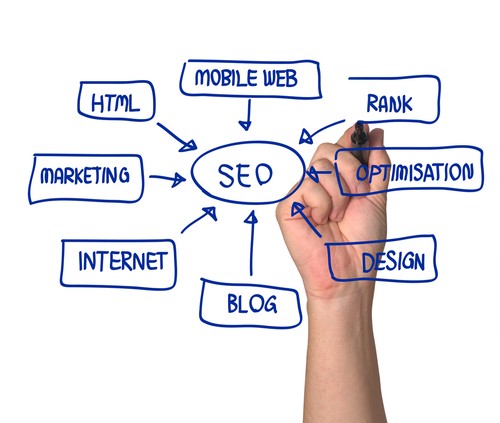Changes in technology inevitably mean changes in the way we shop and do business. It may seem that these innovations favor big enterprise—or that only big corporations can afford them! But the truth is that small businesses have much to gain from embracing new technologies, and these tools are frequently both affordable and cost-effective.
Let’s take a look at five emerging technology trends to watch this year, including specific ways each could help your small business.

Distributed Teams
Between the booming freelance market and the rise of robust cloud collaboration tools, more and more employees are working remotely. Many companies are moving to a partially or even fully distributed team model, which can minimize overhead costs while still enabling employees and business partners to collaborate seamlessly.
According to JT Ripton in “Top Small Business Technology Trends of 2016,” having a distributed team also “dramatically increases the size of your potential talent pool when looking to outsource tasks or fill a position.” Having a roster of talented contractors to draw on allows to access a wider range of specialized skills (and, when needed, add more work hours to a specific project) without paying additional full-time staff salaries.
Improved CRM Solutions
Customer relationship management [CRM] tools help businesses track customers’ actual behavior and communicate accordingly, allowing businesses to nurture and personalize relationships with their patrons. As the SMB Group states in its “2016 Top 10 SMB Technology Trends” report, “SMBs need an integrated, holistic view of their customers,” but, unfortunately, “‘enterprise’ CRM has proved too complicated and costly for most.”
But that reality is rapidly changing: “The good news is that vendors are crafting CRM solutions specifically designed and priced for SMBs. These solutions go beyond contact management to help SMBs improve the customer experience; compete in a social, omnichannel world; and access analytics to stay ahead of their customers’ expectations.”
By using newer, more comprehensive and accessible CRM tools such as Salesforce IQ, Hubspot CRM, andSAP Cloud for Customer, businesses can integrate data from multiple platforms and forms of customer engagement. The results are better interactions and higher customer satisfaction. This is especially important as customers become ever more informed—and more powerful.
Contactless Payment
Mobile payment (or “contactless payment”) options such as Apple Pay, Google Wallet, Square, and Vendio have major benefits for customers and vendors alike.
Contactless payment makes transactions faster and more convenient, minimizing lines at the register and increasing customer satisfaction. They allow your business to better target coupons and discounts to individual customers by integrating with CRM and loyalty program tools. These solutions can also sync with inventory management tools to help you track your stock. And they can significantly cut down on the fees you pay on credit card transactions.
These payment options are already being embraced by some small businesses, but will increase in ubiquity as customers grow ever more mobile-dependent and as the security of these solutions becomes more robust.
Focus on Analytics
Few small businesses currently track analytics for their websites and social media presences. Fewer still effectively implement that data to inform their business decisions.
But according to SMB Group’s report, SMB owners do recognize the importance of analytics, and many plan to invest significantly in this area over the coming year. That investment includes both initial analytics set-up as well as upgrades to cloud-based tools: “Although most of these businesses currently use on-premises analytics solutions, among those planning to purchase or upgrade in this area, 48% plan to use cloud-based analytics solutions. This trend will strengthen in 2016, as more SMBs seek out analytics solutions that are easy to buy and use in order to stay ahead of the market and their competitors.”
As more SMBs integrate analytics into their business strategies, solutions will continue to become more cost-effective and user friendly. Ripton recommends Tableau and QlikView as robust, yet accessible analytics tools for SMB. Whichever solution you choose, it’s a step in the right direction: “Large corporations realize the value of data, and your small business can leverage the power of information too by implementing this kind of software.”
Cybersecurity Upgrades
Cybersecurity is another emerging concern for small businesses. In “SMB Cyber Security Survival Guide,“ “Security Evangelist” Stephen Cobb characterizes SMBs as a “sweet spot” for hackers: more assets for the taking than individuals or families, but frequently less protected than bigger enterprises.
While most SMS owners recognize the growing importance of protecting their systems from threats, they may not yet be adequately equipped to do so. SMB Group writes, “Many SMBs feel overwhelmed, confused, and completely inadequate to deal with the magnitude of the seemingly endless potential for digital security breaches that could wreck havoc on their businesses.”
These businesses need assistance from IT professionals to create cybersecurity plans with protocols for a variety of digital threats (including mobile and cloud concerns). The next step is to implement one of the new “holistic, end-to-end, risk- and rules-based solutions” becoming available to SMBs, explains SMB Group. “These solutions can enable them to close off the biggest vulnerabilities to their most critical corporate data, wherever it resides—whether endpoint devices, mobile apps, on-premises infrastructure, and applications or the cloud.”
What You Need to Know
2016 will be an important year for small business technologies on several fronts. Here are some things to consider:
-
Distributed teams: Are there tasks that you can outsource to remote freelancers? Could entire positions be done from home and allow you to cut some expenses? If so, consider what type of collaboration technology you need to support remote employees.
-
Analytics: Are you tracking—and effectively using—data for your business? This includes customer data (CRM) as well as analytics for your website and social media channels. If you aren’t implementing data in your business decisions, begin tracking analytics with a comprehensive solution like Tableau orQlikView.
-
Cybersecurity: Are your network and data protected from data loss and hackers? If not, consult a cybersecurity expert about your unique needs and develop a plan. Consider a robust digital security system and/or cyber insurance.
- How to Use Business Technology to Thrive in the Future of Hybrid Work - October 19, 2021
- The Breach Within – How to Address the Risk Employees Pose to Your Cybersecurity - September 9, 2021
- The Future of Remote Work and How Collaboration Is Evolving - August 30, 2021



